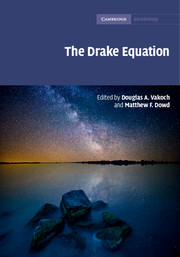Book contents
- The Drake EquationEstimating the Prevalence of Extraterrestrial Life through the Ages
- Cambridge Astrobiology
- The Drake Equation
- Copyright page
- Dedication
- Contents
- Contributors
- Foreword
- Preface
- Book part
- Introduction
- 1 Rate of formation of stars suitable for the development of intelligent life, R*, pre-1961
- 2 Rate of formation of stars suitable for the development of intelligent life, R*, 1961 to the present
- 3 Fraction of stars with planetary systems, fp, pre-1961
- 4 Fraction of stars with planetary systems, fp, 1961 to the present
- 5 Number of planets, per solar system, with an environment suitable for life, ne, pre-1961
- 6 Number of planets, per solar system, with an environment suitable for life, ne, 1961 to the present
- 7 Fraction of suitable planets on which life actually appears, fl, pre-1961
- 8 Fraction of suitable planets on which life actually appears, fl, 1961 to the present
- 9 Fraction of life-bearing planets on which intelligent life emerges, fi, pre-1961
- 10 Fraction of life-bearing planets on which intelligent life emerges, fi, 1961 to the present
- 11 Fraction of civilizations that develop a technology that releases detectable signs of their existence into space, fc, pre-1961
- 12 Fraction of civilizations that develop a technology that releases detectable signs of their existence into space, fc, 1961 to the present
- 13 Length of time such civilizations release detectable signals into space, L, pre-1961
- 14 Length of time such civilizations release detectable signals into space, L, 1961 to the present
- Afterword
- Index
- References
5 - Number of planets, per solar system, with an environment suitable for life, ne, pre-1961
Published online by Cambridge University Press: 05 July 2015
- The Drake EquationEstimating the Prevalence of Extraterrestrial Life through the Ages
- Cambridge Astrobiology
- The Drake Equation
- Copyright page
- Dedication
- Contents
- Contributors
- Foreword
- Preface
- Book part
- Introduction
- 1 Rate of formation of stars suitable for the development of intelligent life, R*, pre-1961
- 2 Rate of formation of stars suitable for the development of intelligent life, R*, 1961 to the present
- 3 Fraction of stars with planetary systems, fp, pre-1961
- 4 Fraction of stars with planetary systems, fp, 1961 to the present
- 5 Number of planets, per solar system, with an environment suitable for life, ne, pre-1961
- 6 Number of planets, per solar system, with an environment suitable for life, ne, 1961 to the present
- 7 Fraction of suitable planets on which life actually appears, fl, pre-1961
- 8 Fraction of suitable planets on which life actually appears, fl, 1961 to the present
- 9 Fraction of life-bearing planets on which intelligent life emerges, fi, pre-1961
- 10 Fraction of life-bearing planets on which intelligent life emerges, fi, 1961 to the present
- 11 Fraction of civilizations that develop a technology that releases detectable signs of their existence into space, fc, pre-1961
- 12 Fraction of civilizations that develop a technology that releases detectable signs of their existence into space, fc, 1961 to the present
- 13 Length of time such civilizations release detectable signals into space, L, pre-1961
- 14 Length of time such civilizations release detectable signals into space, L, 1961 to the present
- Afterword
- Index
- References
Summary
The Drake Equation factor ne, the number of planets per planetary system with an environment suitable for life, has recently received increased attention as astronomers discover many planetary systems within the Milky Way. This factor is closely associated with the notion of planetary habitability, which is not new. During the second part of the nineteenth century, astronomers such as Richard Proctor (1837–1888) and Camille Flammarion (1842–1925) studied planetary habitability in our solar system a century before this concept was updated by the systematic exploration of the solar system and the detection of exoplanets. The question was tackled in scientific terms while studies of the Martian surface were intensifying. The term “habitability” was used mainly for Mars, which was regarded as a sister planet of Earth and looked like a possible abode for life. More generally, studies during this period attempted to compare Earth with other planets in the solar system, in spite of the lack of accurate data on their environments. Analogy soon became the basic way in which to calculate the level of habitability of each planet. In the meantime, spectroscopy was developing quickly and began to provide more data about planetary atmospheres.
At the dawn of the space age, Hubertus Strughold (1898–1987) suggested that we examine the planets of the solar system using the concept of “planetary ecology.” This notion was very similar to the concept of habitability employed earlier by nineteenth-century pioneers. Strughold also coined the term “ecosphere” to describe the region around a star that has conditions suitable for life-bearing planets, a concept equivalent to the habitable zone. A decade later, Stephen Dole redefined the concept of habitability as the planetary conditions suitable for human life. He used probability methods to estimate the number of planets in the galaxy where human life might be possible. This chapter reviews the main historical contributions up to the 1960s regarding the concept of planetary habitability and its different meanings over time.
- Type
- Chapter
- Information
- The Drake EquationEstimating the Prevalence of Extraterrestrial Life through the Ages, pp. 90 - 113Publisher: Cambridge University PressPrint publication year: 2015

